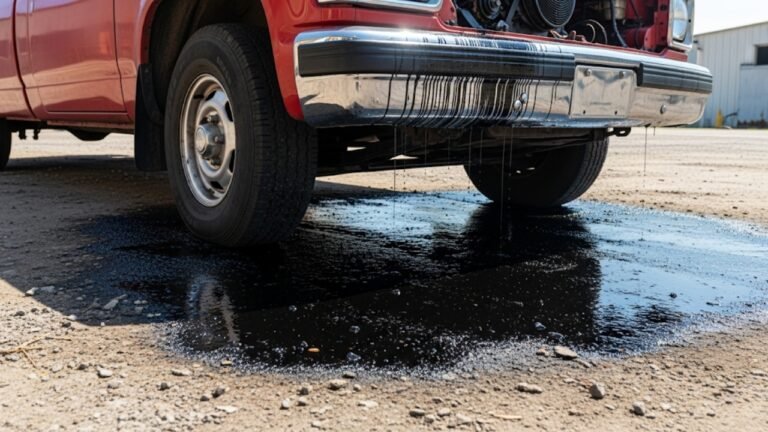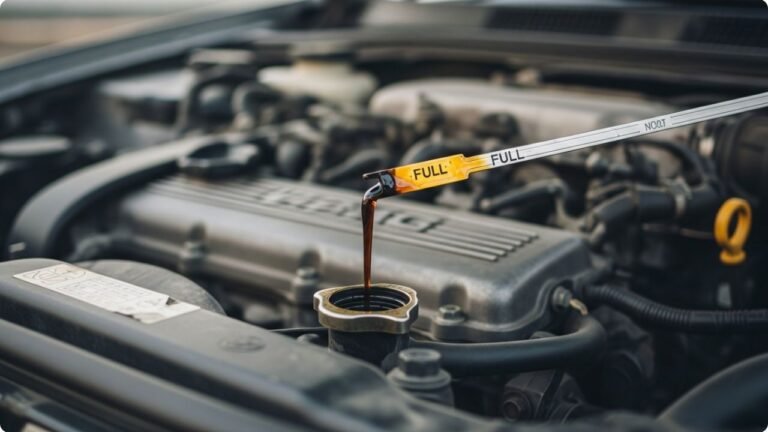When Should I Change Oil in My Car?

Let’s be real. Owning a car is exciting—until those little warning lights pop up and make your heart skip a beat. One of the most common and essential things you’ll hear about is an oil change. You may have asked yourself: when should I change oil in my car? The answer isn’t always a simple number on your dashboard. It’s more like asking when you should eat—depends on your hunger, schedule, and a bit of habit.
Imagine your engine as the heart of your car and engine oil as the lifeblood. It keeps things flowing, smooth, and cool. Without it—or when it’s old and dirty—your car starts to age quickly. If you’re like me, you might have ignored that sticker on the windshield more than once. But what I learned the hard way is that regular oil changes are like brushing your teeth—you skip it long enough, and the damage adds up.
Let’s dive into the details of when you should change oil in your car, and I’ll share everything I’ve learned—through research, experience, and a few expensive lessons.
Old Rules vs. Modern Engines: A Shift in Thinking

The reality? Most newer cars can go 5,000 to 10,000 miles between oil changes, depending on your driving habits and oil type. That’s a huge range, and it’s easy to get lost in the numbers. So let’s break it down:
-
Conventional oil: Change every 3,000 to 5,000 miles
-
Synthetic blend: Around 5,000 to 7,500 miles
-
Full synthetic oil: Usually 7,500 to 10,000 miles or more
But these are just estimates. The best way to know when to change oil in your car is by checking your owner’s manual. Yep, that little book in the glove box that we all ignore.
My car, a 2018 Toyota Corolla, goes 7,500 miles on synthetic oil. I used to change it every 5,000 just because I was scared. But once I understood the intervals better and trusted the manual, I started saving money without sacrificing performance.
Listen to Your Driving Style: It Talks Back
Your driving style is a big part of this equation. If you’re always on the highway, cruising at a steady speed, your oil lasts longer. But if you’re stuck in traffic every morning, making short trips, or driving in extreme heat or cold—your oil wears out faster.
I live in Phoenix, and summers here are no joke. It gets up to 110°F. I used to drive short 10-minute trips in stop-and-go traffic. That’s hard on the engine. Even with full synthetic oil, I noticed the oil looked dirty at 5,000 miles. So I adjusted my change interval to every 6,000 miles instead of 7,500.
Ask yourself:
-
Do you sit in traffic daily?
-
Do you make short trips under 10 miles?
-
Do you drive in dusty, humid, or cold conditions?
If you answered yes, it’s better to change your oil sooner rather than later. Your car may not thank you with words, but it’ll run smoother and last longer.
Signs Your Car is Asking for an Oil Change
Your car isn’t always going to flash a warning light. Sometimes, it whispers. Here are some quiet (and not-so-quiet) signs that it’s time for an oil change:
-
Engine noise gets louder than usual
-
Oil looks dark, thick, or dirty on the dipstick
-
You smell burning oil or exhaust
-
The “check engine” light flickers or stays on
-
Your fuel efficiency takes a hit
-
You notice oil leaks under the car
I once ignored the burning smell in my old Honda Civic and kept driving for weeks. Turns out the oil was almost gone. I learned the hard way: those smells matter. Trust your senses.
Here’s a quick table to help identify the symptoms:
| Symptom | What It Means | What To Do |
|---|---|---|
| Engine sounds louder | Oil is thin or broken down | Check and top off or change |
| Oil is dark/dirty | It’s full of contaminants | Time for a full change |
| Burning smell | Oil is leaking onto hot parts | Visit a mechanic ASAP |
| Lower MPG | Engine working harder without proper lube | Change oil and filter |
| Oil light on dashboard | Low pressure or oil level | Don’t delay—check immediately |
Using the Oil Life Monitoring System (OLMS)
Most modern cars have what’s called an Oil Life Monitoring System. It’s a little indicator on your dashboard that measures your driving conditions and tells you when to change the oil. It’s not just counting miles—it’s smart. It considers how hard the engine is working, how often you start and stop, and even how cold it is outside.
When that light comes on, it’s not just a suggestion—it’s a sign from your car that it’s ready for a refresh.
I used to reset the oil life manually, thinking I could squeeze in a few extra miles. But the system was right. When I listened to it, my car felt peppier, and the engine didn’t sound tired.
When should I change oil in my car?—if your OLMS says now, don’t put it off.
The Type of Oil Matters—A Lot
Think of oil like skincare for your car. You wouldn’t use sunscreen at night or a heavy moisturizer before working out. Your car feels the same about oil.
There are different types of oil: conventional, synthetic, synthetic blend, and high-mileage. Each serves a purpose:
-
Conventional oil: Good for older cars and basic engines
-
Synthetic oil: Best for newer cars, high performance, or extreme temperatures
-
Synthetic blend: A mix of both; great for moderate needs
-
High-mileage oil: Designed for cars with over 75,000 miles; reduces leaks and oil burn
If you’re not sure what oil your car needs, the owner’s manual (again!) or a trusted mechanic can help. I tried switching to full synthetic in my high-mileage Ford Focus, and wow—the engine smoothed out like I gave it a spa day.
How Skipping Oil Changes Hurts Your Engine
Let me put it this way: skipping an oil change is like running a marathon without drinking water. At first, you’ll keep going. But sooner or later, something breaks down. And when it does, it’s going to cost more than a couple bottles of water—or in this case, an oil change.
When you delay changing your oil, the engine oil loses its viscosity (that’s just a fancy word for thickness). It stops lubricating your engine the way it should. Dirt, carbon, and metal particles start to build up. These tiny bits work like sandpaper, grinding your engine from the inside.
Over time, this leads to:
-
Sludge buildup in your engine
-
Increased friction, causing parts to wear faster
-
Overheating, especially during long drives
-
Poor fuel efficiency
-
A shorter engine lifespan
I once drove my Jeep an extra 3,000 miles past its due date. It ran fine until one day the engine seized while I was on the highway. The mechanic said the oil had turned into black goo. That mistake cost me over $1,200 in repairs. Ever since, I’ve taken oil changes seriously.
Changing oil on time is cheaper than fixing what happens when you don’t.
Seasonal Factors You Might Be Missing
Did you know the weather can affect your oil change schedule? Just like your wardrobe changes with the seasons, your car’s engine needs some seasonal attention too.
In cold winters, oil thickens and doesn’t flow easily. If you’re starting your car in below-freezing temps, that thick oil struggles to get where it’s needed. This causes more wear during the first few minutes after startup.
In hot summers, oil thins out and can evaporate faster, especially in older engines. That means less protection and more strain on the moving parts.
What can you do?
-
Use oil with the right viscosity grade (like 5W-30 for cold climates)
-
Change oil before extreme seasons begin (spring and fall are good checkpoints)
-
Check oil more frequently during heatwaves or snowstorms
I once made a road trip from Chicago to Arizona in the middle of July. The desert heat made my engine work double-time. I changed the oil right after the trip, and I’m glad I did—the old oil looked like burnt syrup.
Pay attention to the seasons. They don’t just affect your mood—they affect your engine, too.
Oil Filter: The Unsung Hero of Oil Changes
Changing oil without changing the oil filter is like pouring clean water into a dirty glass. Sure, it’s better than nothing, but it won’t stay clean for long.
The oil filter traps dirt, metal bits, and sludge that build up as oil moves through the engine. Over time, the filter gets clogged. If you don’t replace it, that gunk flows right back into the engine.
Every time you ask, “when should I change oil in my car?”, also ask: “Am I changing the filter too?”
It only costs a few extra bucks, but it makes a huge difference. I used to skip it, thinking it wasn’t necessary. But once I started changing both at the same time, my car started idling quieter and smoother. It’s the small stuff that adds up.
DIY or Mechanic: What’s Best for Oil Changes?
If you’re handy with tools and don’t mind getting your hands dirty, doing your own oil change can save you money. But it’s not for everyone.
Here’s a quick comparison:
| Option | Pros | Cons |
|---|---|---|
| DIY | Saves money, gives control | Takes time, can be messy |
| Mechanic/Garage | Fast, includes inspection, safe disposal | Costs more, possible upselling |
| Quick Lube Shops | Convenient, no appointment needed | May not use top-quality oil |
I tried doing it myself for a year. It was fun at first—like a weekend project. But I eventually returned to using a trusted local mechanic who doesn’t push unnecessary services. It’s all about what fits your lifestyle and budget.
Just make sure that whoever does the oil change uses the right oil type and replaces the filter.
Mileage vs. Time: Which One Matters More?
Most people focus on mileage. But did you know time is just as important? Oil breaks down even if your car is sitting in the garage. That means even if you only drive 2,000 miles in six months, your oil might still need to be changed.
I had a friend who works from home and barely drives. She thought she could go a year without an oil change because she hadn’t hit 5,000 miles. When she finally checked, her oil had the consistency of molasses.
Rule of thumb: If your car has been sitting for more than six months, check the oil. Better yet, just change it.
The Cost of Neglect vs. The Price of Prevention
Here’s the math most of us forget:
-
Average oil change: $40–$70
-
Engine repair from bad oil: $1,000+
-
Cost of a new engine: $4,000–$10,000
-
Peace of mind: Priceless
When you look at it this way, spending $50 every few months is a no-brainer. I used to think it was a waste of money—until I experienced what happens when you don’t.
Every time I hand over my keys for an oil change now, I feel like I’m giving my car a wellness check-up. A small price for long-term health.
Your Car is Talking—Start Listening
Cars are smarter than ever, but they still rely on us to make the right choices. When you hear a rattle, see a light, or just feel something’s off—don’t ignore it. Think of your car like a friend who’s giving you signs. Would you ignore a friend who’s feeling sick?
I’ve learned that answering the question, “when should I change oil in my car?”, doesn’t just save money. It saves stress, time, and future regret. And just like with anything important, being proactive beats being reactive every time.
Final Thoughts: Change Oil, Change Everything
Let’s wrap this up with some real talk.
Changing your oil on time might feel like a chore. But it’s one of the most powerful things you can do to protect your car. It keeps the engine healthy, extends your vehicle’s life, and prevents costly breakdowns.
Don’t wait until it’s too late. Don’t rely on myths or guesswork. And definitely don’t treat your car like it’s invincible.
Next time you wonder, “when should I change oil in my car?”, think about everything we’ve talked about here: your driving style, the weather, the oil type, and your car’s signals. Let all those pieces guide your decision.
Your car takes care of you every day. Return the favor—with clean oil and a little attention.






